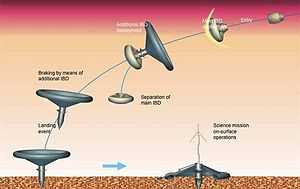MetNet
 | |
| Operator | Finnish Meteorological Institute |
|---|---|
| Mission type | Multi-lander network |
| Launch date | 2014-2019[1] |
| Launch vehicle | Zenit launch vehicle / Volna |
MetNet is an atmospheric science mission to Mars, initiated and defined by the Finnish Meteorological Institute. The mission includes sending several tens of MetNet landers on the Martian surface. The objective is to establish a widespread surface observation network on Mars to investigate the planet's atmospheric structure, physics and meteorology. A precursory mission consisting of one lander is scheduled for launch in the launch window starting from 2014.
Concept and goals
The fact that both meteorology in particular and climatology in general vary both temporally and spatially means that the most effective means of monitoring these is to make simultaneous measurements at multiple locations and over a sufficiently long period of time. Bearing this in mind, MetNet includes both a global-scale, multi-point network of surface probes supplemented by a supporting satellite in orbit, for a projected duration of two Martian years. Somewhere in the range of ten to twenty observation points is seen as a minimum to get a good picture of atmospheric phenomena on a planet-wide scale.[2]
Lander concept

The MetNet Lander vehicle will use inflatable entry and descent systems instead of rigid heat shields and parachutes as earlier semi-hard landing devices have used. This way the ratio of the payload mass to the overall mass is optimized, and more mass and volume resources are spared for the science payload. The MetNet Lander's atmospheric descent process can be partitioned into two phases: the primary aerodynamic or the 'Inflatable Braking Unit' deceleration phase, and the secondary aerodynamic or the 'Additional Inflatable Braking Unit' deceleration phase. The operational lifetime of a lander on the Martian surface will be seven years.[3]
Status
The descent vehicle has been fully qualified for Martian environment. Development of a precursory mission is under way[4] and its launch is planned during the launch windows starting from 2014.[1] The precursory mission will consist of one lander and is intended as a technology and science demonstration mission. More landers will be deployed in the following launch windows extending up to 2019.[4]
Precursory mission
For the earlier launch window, two delivery concepts were being considered:[5]
- Piggyback delivery attached to the Russian Phobos Grunt Sample Return mission.
- Dedicated launch using the Russian Volna — a converted Submarine/Sea-Launched Ballistic Missile (SLBM).
The FMI announced it would launch the demonstration lander on board the Phobos Grunt mission on 2011. However, the MetNet lander was later dropped from the Phobos-Grunt mission due to weight constraints on the spacecraft. Phobos-Grunt later failed to depart Earth orbit and crashed into the Pacific Ocean on January 16, 2012.[6] The precursory mission is now planned for the 2014 launch window.[1]
The key contributions of the precursory mission are:[7]
- Availability of new and high-quality resolution atmospheric vertical structures as well as long-duration (of the order of a Martian year) in situ meteorological and imaging observations at a single or few landing site(s).
- Demonstrate feasibility of the lander concept for a meteorological network mission.
Development
MetNet is a "successor" of the NetLander Mission's atmospheric leg. It is also continuance of the Russian Mars 96 mission. MetNet design was started in August 2000 while development has been going on since 2001.[8]
MetNet is being developed by a consortium consisting of the Finnish Meteorological Institute (Mission Lead), the Russian Space Research Institute (Payload Lead, in cooperation with Lavochkin Association), and Instituto Nacional de Técnica Aeroespacial (INTA) from Spain.
References
- ↑ 1.0 1.1 1.2 "MetNet Precursor Mission - The Launch Date". Finnish Meteorological Institute.
- ↑ "Definition of science objectives". Finnish Meteorological Institute.
- ↑ "MetNet The New Generation of Atmospheric Observation for Mars" (PDF). European Planetary Science Congress. 2008.
- ↑ 4.0 4.1 A.-M. Harri, W. Schmidt, K. Pichkhadze, V. Linkin, L. Vazquez, M. Uspensky, J. Polkko, M. Genzer, A. Lipatov, H. Guerrero, S. Alexashkin, H. Haukka, H. Savijarvi, J. Kauhanen (2008). "Mars MetNet Precursor Mission" (PDF). European Planetary Science Congress.
- ↑ "MetNet Mars Precursor Mission". Finnish Meteorological Institute.
- ↑ "Russian space probe crashes into Pacific Ocean". Fox News. 15 January 2012.
- ↑ "MetNet Mars Precursor Mission science objectives". Finnish Meteorological Institute.
- ↑ MetNet - Precursor Mission Overview
External links
| Wikimedia Commons has media related to MetNet. |
- Introduction to the MetNet Mars Mission
- MetNet Mission Poster PDF
- "Space technology – a forerunner in Finnish-Russian high-tech cooperation". Energy & Enviro Finland. October 17, 2007.
- A.-M. Harri, J. Leinonen, S. Merikallio, M. Paton, H.Haukka, J. Polkko, Prof. V. Linkin, V. Lipatov, Director General K. Pichkadze, A. Polyakov, M. Uspensky, Prof. L. Vasquez, Dr. H. Guerrero, D. Crisp, R. Haberle, S. Calcutt, C. Wilson, Prof. P. Taylor, Prof. C. Lange, M. Daly, L. Richter, R. Jaumann, J.-P. Pommereau, F. Forget, Ph. Lognonne, J. Zarnecki (2007). MetNet — In Situ Observational Network and Orbital Platform to Investigate the Martian Environment (PDF). Helsinki: Finnish Meteorological Institute. ISBN 978-951-697-625-2.
- "Future Plans for MetNet Lander Mars Missions".
- "Mars MetNet Mission Payload Overview".
| ||||||||||||||||||||||||||||||||||||||||||
| ||||||||||||||||||||||||||||||||||||


